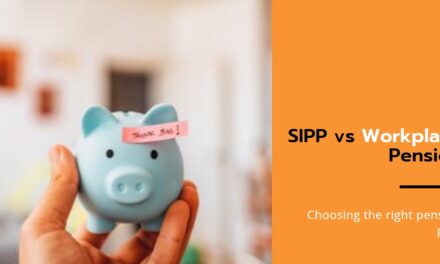Two of the most popular savings and investment accounts in the UK are Self-Invested Personal Pensions (SIPPs) and Individual Savings Accounts (ISAs).
In this guide, we’ll delve deeper into the differences between SIPPs vs ISAs, discuss their pros and cons in detail, and explain the tax implications of each.
We’ll also explore the types of investments you can hold in SIPPs and ISAs, and answer some frequently asked questions.
What’s the difference between a SIPP and an ISA?
In a nutshell, a SIPP is better for long-term savings, and an ISA is better for shorter-term savings.
The two main differences between a SIPP vs ISA are:
SIPPs have tax relief on contributions, but you can’t withdraw until you’re at retirement age (currently 55 but going up to 57 in 2028).
ISAs are tax-efficient (free from income and capital gains tax like SIPPs) but you don’t get tax relief on your contributions, but you can also withdraw your money at any point.
Here’s a table summing up the key points:
| SIPP | ISA | |
|---|---|---|
| Purpose | Retirement savings | Savings and investments for various goals |
| Access to funds | Restricted until minimum pension age (currently 55) | Flexible, can withdraw at any time |
| Tax relief | On contributions in line with income tax brackets | None |
| Tax treatment | Tax-free growth, withdrawals taxed as income (except for 25% tax-free lump sum) | Tax-free growth and withdrawals |
| Investment options | Wider range, including commercial property and unlisted shares | More limited (depending on provider), mainly shares, bonds, and funds |
| Annual limit | £60,000 or 100% of your relevant UK earnings (whichever is lower) | £20,000 across all types of ISAs |
| Age restrictions | Can’t access funds before minimum pension age | No age restrictions on withdrawals |
And here’s a more detailed breakdown:
SIPPs
A Self-Invested Personal Pension (SIPP) is a type of private pension scheme that offers a tax-efficient and flexible way to save for retirement.
Unlike traditional pension plans, SIPPs give you full control over the investments within the plan. This means you can choose from a wide range of assets, including shares, bonds, funds, ready-made portfolios, and even commercial property.
The government provides tax relief on your SIPP contributions, which effectively means you’re investing pre-tax income.
This tax relief is added directly to your pension pot and is based on your income tax rate.
Keep in mind that there’s an annual allowance for pension contributions (either £60,000 or your annual income, whichever is lower).
However, SIPPs come with restrictions on when you can access your money. Typically, you can’t withdraw funds from your SIPP until you reach the minimum pension age, which is currently 55, although it’s going up to 57 in 2028.
ISAs
An Individual Savings Account (ISA) is a tax-efficient savings and investment account that allows you to save and invest money without paying tax on interest, dividends, or capital gains.
ISAs are more flexible than SIPPs, as you can withdraw money at any time without facing penalties. There are different types of ISAs available, each catering to specific financial needs:
- Cash ISAs: These are savings accounts where you can deposit cash and earn tax-free interest.
- Stocks and Shares ISAs: In these accounts, you can invest in a variety of assets, such as stocks, bonds, and funds, with tax-free growth and income.
- Lifetime ISAs: Designed for first-time homebuyers and retirement savings, these accounts offer a government bonus of 25% on contributions up to a certain limit each year.
- Innovative Finance ISAs: These accounts allow you to invest in peer-to-peer lending platforms, earning tax-free interest on loans to individuals or businesses.
Each tax year, you have an annual ISA allowance that determines the maximum amount you can contribute across all types of ISAs. For the 2024/2025 tax year, the ISA allowance is £20,000.
The pros and cons of SIPPs and ISAs
To help you decide which investment vehicle is best suited to your needs, let’s take a closer look at the main advantages and disadvantages of SIPPs and ISAs:
| SIPP | ISA | |
| Pros | – Tax relief on contributions | – Tax-free savings and investments |
| – Wide range of investment options | – Flexibility to withdraw at any time | |
| – Potentially higher returns due to tax relief | – Variety of ISA types to suit different needs | |
| – Can consolidate multiple pension pots into one SIPP | – No age restrictions on withdrawals | |
| Cons | – Limited access before minimum pension age (currently 55) | – Annual contribution limits |
| – Complexity and potential fees | – Potentially lower returns due to lack of tax relief | |
| – Taxed as income upon withdrawal in retirement (except for 25% tax-free lump sum) | – Potentially fewer investment options compared to SIPPs |
The tax differences explained
Tax treatment is one of the key differences between SIPPs and ISAs.
SIPPs offer tax relief on your contributions.
This means that the government adds a top-up to your pension pot based on your income tax rate.
For example, if you’re a basic-rate taxpayer, you’ll receive a 25% top-up on your contributions, while higher and additional-rate taxpayers can claim more tax relief through their tax returns.
The investments within a SIPP grow tax-free. However, when you start withdrawing money from your SIPP in retirement, 75% of the withdrawals will be taxed as income. The remaining 25% can be taken as a tax-free lump sum.
ISAs, on the other hand, do not offer tax relief on contributions, but they do provide tax-free growth on investments and tax-free withdrawals. This means you won’t pay any tax on interest, dividends, or capital gains from your ISA investments.
What investments can you hold in SIPPs and ISAs?
Both SIPPs and ISAs allow you to invest in a range of assets, although SIPPs generally offer a broader selection.
SIPPs
In a SIPP, you can invest in:
- Stocks and shares
- Bonds, including corporate and government bonds
- Funds, such as unit trusts, investment trusts, and exchange-traded funds (ETFs)
- Commercial property and real estate investment trusts (REITs)
- Ready-made portfolios and managed portfolios
SIPPs also provide the option to hold cash as part of your portfolio, which can be useful for managing short-term liquidity or keeping a portion of your savings in a low-risk asset.
ISAs
In a Stocks and Shares ISA, you can invest in:
- Stocks and shares
- Bonds, including corporate and government bonds
- Funds, such as unit trusts, investment trusts, and exchange-traded funds (ETFs)
- Ready-made portfolios and managed portfolios
While the range of investments available in an ISA might be more limited compared to a SIPP depending on your provider, it still provides ample opportunities for diversification and growth.
FAQs
Why choose a SIPP over an ISA?
A SIPP could be the right choice if you’re focused on saving for retirement and want to take advantage of the tax relief on pension contributions.
The wide range of investment options, potential for higher returns due to tax relief, and ability to consolidate multiple pension pots make SIPPs a popular choice for long-term retirement planning.
How many SIPPs can I open in one year?
There’s no limit to the number of SIPPs you can open in a year.
However, it’s worth considering that managing multiple SIPPs might become complex and time-consuming.
Additionally, the annual allowance for pension contributions applies to all your pension savings, not just SIPPs.
Can I have a SIPP and ISA at the same time?
Yes, you can have both a SIPP and an ISA at the same time. Many people use ISAs for shorter-term savings and SIPPs for long-term retirement planning.
Combining the two can offer diversification and flexibility in terms of accessing your funds.
Should I move money from my ISA to my SIPP?
Transferring money from an ISA to a SIPP can make sense if you want to benefit from the tax relief on pension contributions and prioritise long-term retirement savings.
However, remember that once the money is in a SIPP, you’ll face restrictions on accessing it before the minimum pension age.
Additionally, transferring money from an ISA to a SIPP may involve fees or charges, so it’s important to weigh the potential benefits against the costs. You’ll need to withdraw your money from your ISA and then add it back to your SIPP, so factor in the fees at every step.




